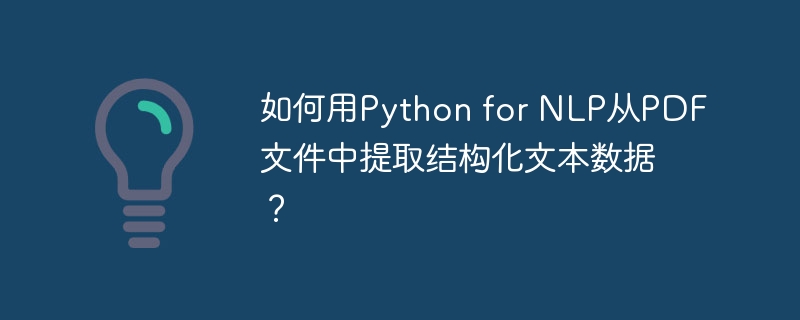

How to extract structured text data from PDF files using Python for NLP?
Introduction:
Natural language processing (NLP) is one of the important branches in the field of artificial intelligence. Its goal is to enable computers to understand and process human language. Text data is the core resource of NLP, so how to extract structured text data from various sources has become a basic task of NLP. PDF files are a common document format. This article will introduce how to use Python for NLP and extract structured text data from PDF files.
Step 1: Install dependent libraries
First, we need to install some necessary Python libraries to process PDF files. Among them, the most important is the PyPDF2 library, which can help us read and parse PDF files. The PyPDF2 library can be installed through the following command:
pip install PyPDF2
Step 2: Read PDF file
Before we begin, we need to prepare a sample PDF file for demonstration. Suppose our sample PDF file is named "sample.pdf". Next, we will use the PyPDF2 library to read the PDF file as follows:
import PyPDF2
filename = "sample.pdf"
# 打开PDF文件
pdf_file = open(filename, 'rb')
# 创建一个PDF阅读器
pdf_reader = PyPDF2.PdfReader(pdf_file)
# 获取PDF文件中的页数
num_pages = pdf_reader.numPages
# 逐页提取文本
text_data = []
for page in range(num_pages):
page_obj = pdf_reader.getPage(page)
text_data.append(page_obj.extractText())
# 关闭PDF文件
pdf_file.close()In the above code, we first open the PDF file and then create a PDF reader using the PyPDF2 library. After that, we get the page number of the PDF file and use a loop to extract the text content page by page and store the extracted text data in a list. Finally, remember to close the PDF file.
Step 3: Clean text data
The text data extracted from PDF files often contains a large number of blank characters and other irrelevant special characters. Therefore, we need to clean and preprocess the text data before proceeding to the next step. Here is an example of a simple text cleaning function:
import re
def clean_text(text):
# 去除多余的空白字符
text = re.sub('s+', ' ', text)
# 去除特殊字符
text = re.sub('[^A-Za-z0-9]+', ' ', text)
return text
# 清理文本数据
cleaned_text_data = []
for text in text_data:
cleaned_text = clean_text(text)
cleaned_text_data.append(cleaned_text)In the above code, we first use regular expressions to remove extra whitespace characters and then remove special characters. Of course, the text cleaning method can be adjusted according to the actual situation.
Step 4: Further processing of text data
In the above steps, we have extracted the structured text data from the PDF file and performed a simple cleaning. However, depending on the specific application requirements, we may need to perform further text processing. Here, we will briefly introduce two common text processing tasks: word frequency statistics and keyword extraction.
Word frequency statistics:
Word frequency statistics is one of the common tasks in NLP. Its purpose is to count the number of times each word appears in the text. The following is a simple example of word frequency statistics:
from collections import Counter # 将文本数据拼接为一个字符串 combined_text = ' '.join(cleaned_text_data) # 分词 words = combined_text.split() # 统计词频 word_freq = Counter(words) # 打印出现频率最高的前10个词语 print(word_freq.most_common(10))
Keyword extraction:
Keyword extraction is an important task in NLP, and its purpose is to extract the most representative keywords from text data . In Python, we can use the textrank4zh library for keyword extraction. The example is as follows:
from textrank4zh import TextRank4Keyword
# 创建TextRank4Keyword对象
tr4w = TextRank4Keyword()
# 提取关键词
tr4w.analyze(text=combined_text, lower=True, window=2)
# 打印关键词
for item in tr4w.get_keywords(10, word_min_len=2):
print(item.word)In the above code, we first create a TextRank4Keyword object, and then call the analyze() method to extract keywords. After that, we can get the specified number of keywords through the get_keywords() method, the default is the first 10 keywords.
Conclusion:
This article introduces how to use Python for natural language processing (NLP) and extract structured text data from PDF files. We used the PyPDF2 library to read and parse PDF files, and then performed simple text cleaning and preprocessing. Finally, we also introduced how to perform word frequency statistics and keyword extraction. I believe that through the introduction of this article, readers can master how to extract structured text data from PDF files and further apply it to natural language processing tasks.
The above is the detailed content of How to extract structured text data from PDF files with Python for NLP?. For more information, please follow other related articles on the PHP Chinese website!




